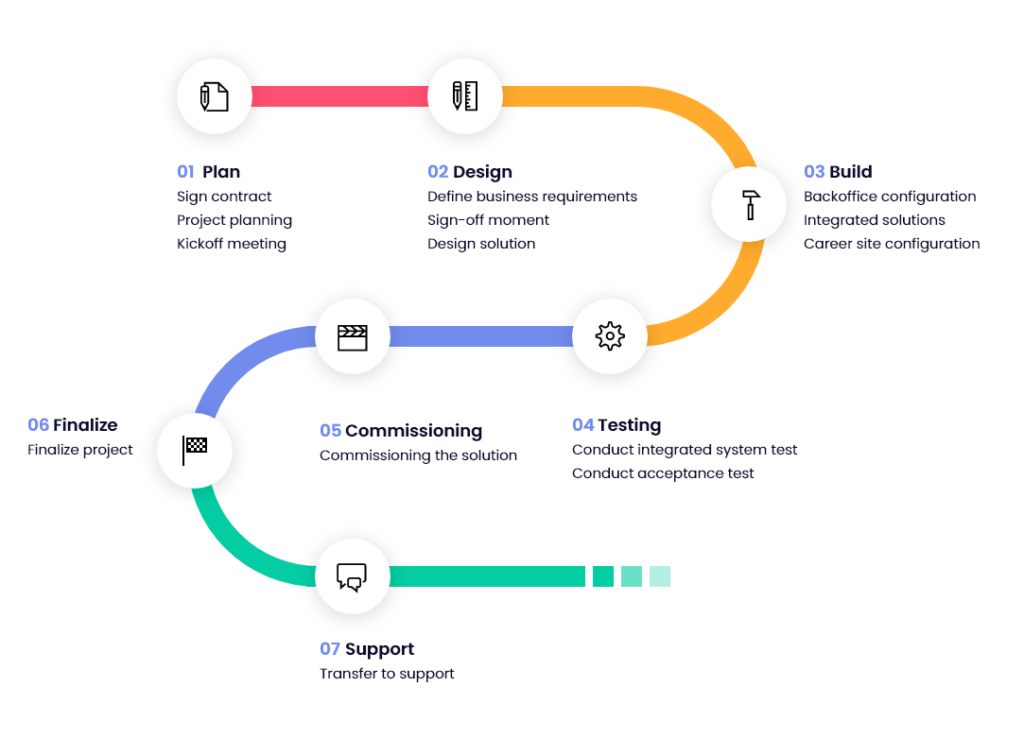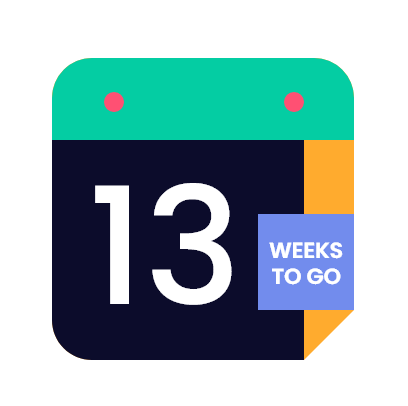




- Recruitment software
- Solutions
company size
Featured Industries
- Resources
- Contact
- English
The implementation of a new ATS: it’s a significant, intensive and therefore a complicated process, right? It is too simplistic to call it straightforward, but with the right approach and planning it is quite possible to achieve this without unnecessary bumps and setbacks.
The right preparation is pivotal for proper implementation of the ATS. We then use 7 steps, subdividing the implementation into the different stages.
A demo (most likely) and brief description by Ubeeo shows clearly who we are, what we do and what the building blocks of our product are. The preparation for the actual implementation therefore starts with a kick-off meeting. Preferably everyone who will be using the product is present from the start. This can include:
A diverse team makes sure that all bases are covered, to avoid overlooking any important matters following the kick-off meeting. You want to avoid having a Security Officer point out a day before the final launch that, for example a PEN test hasn’t been carried out yet.
So make sure anything that isn’t feasible, or anything that needs to be done, and what the benefits and the resulting processes may be, is clarified during the preparation. And communicate this clearly internally, so that both the strategic decision makers and everyone who has to provide input, are on the same page.
We implement our ATS in 7 clear steps. We plan, design, build, test, commission, disconnect, and provide the necessary support. And while typical consultants develop all kinds of fancy models and names for this, we like to keep it real. And if we have to, we call it the JBF method. An inside joke we like to share with our fantastic clients, if they really want to know, of course
We complete the 7 steps using Monday, in our opinion the best tool for collaborating. We set up the platform based on everything we discuss during the kick-off meeting. The dashboard makes clear who is working on what, what still needs to be done and what has been completed, all at a glance.

A good implementation requires a clear plan. It is an important phase, during which we of course sign the contract and plan the project. Next up is the kick-off meeting, for which it is important to invite various teams to the table.
What to expect for the design phase. We start with the business requirements as they emerge from the kick-off meeting. Based on the requirements, we draw up the plan and design the necessary solutions.
Together with the client, we determine what is required to ensure all internal processes are incorporated into the system. This is also the time when we consider the integrated solutions that will be necessary. For example, integrated solutions with a testing agency, your own website, the Intranet, or for transferring vacancies to job posters.
Then comes the construction. We install the software based on the priorities and wishes that emerge as a result of the kick-off meeting. In addition, we start with the designed solution(s), as discussed in the previous step.
We build the actual solution, in which we develop the back office. We also build the integrated solutions and the careersite, to use later.
During this stage we set up the system and prepare it for the test phase. If possible, testing starts on parts that have been completed, while we continue to build on the parts that are yet to be completed.
As soon as the parts have been built, we start the testing phase. We test the separately built components and then the integral system, as it is intended work. Finally, we do an acceptance test. After this we sign off on the project to give the go-ahead for the next step.
The test phase also includes training for our clients. In 3 hours we explain all the ins and outs of the system and point out useful functionalities and important settings. In the meantime, the client makes a plan for good internal communication, to clearly indicate what will change in the way of working.
It is particularly important to make the changes very clear, as well as the benefits the system offers and a description of how employees will be working with it. We have experience with this, although it is the client who ultimately has to manage this and garner enough support. Without the right support, implementation often proves more difficult in practice.
The commissioning is the actual launch moment for the ATS. It is an exciting and important step during the implementation, which shows whether or not what we have built and tested in practice, does what the client expects.
We always do the launch on a Tuesday. We do this deliberately, because a Monday is less suitable. Lastminute changes or updates are commonplace. This is possible on a Monday coming up to Tuesday, but more difficult on a Sunday leading up to Monday.
In addition, we ask for an evaluation by the client after the system has been put into use. We operate fully ISO 9001-certified, so as part of the processes we collect feedback on the implementation of the ATS. Of course, we aim to address any comments or feedback, while celebrating everything that the client is happy with.
Ultimately, our support is available for any questions, technical challenges and uncertainties that remain after the training. In the meantime, we ensure an easy transition from intensive contact during implementation, into the support phase
We work with support tickets, which we handle quickly, making sure the right specialist is assigned to respond personally to the query. During the last few conversations and contact moments, we explain how support works, so the client knows exactly how they can reach us.

The implementation of an ATS takes 13 weeks standard. That may seem like a long time, but in practice this goes much faster than you would think. It gives the client the space to draft new internal emails, take photos and arrange everything they need to prepare.
Furthermore, it leaves some time for potential setbacks or lastminute extras that need to be added. And if the client prefers to take more time? It is possible to agree on phase 1 in 13 weeks, which allows more time for the subsequent stages. This way we prevent an open ending, with the end date ultimately only getting pushed back further.
